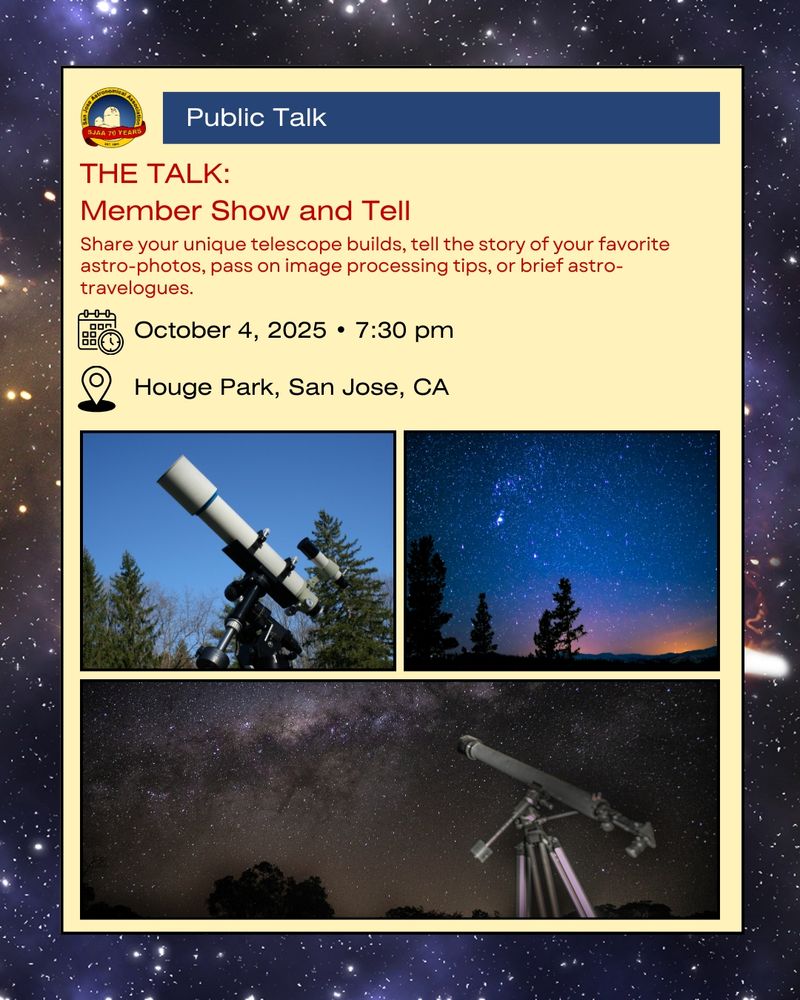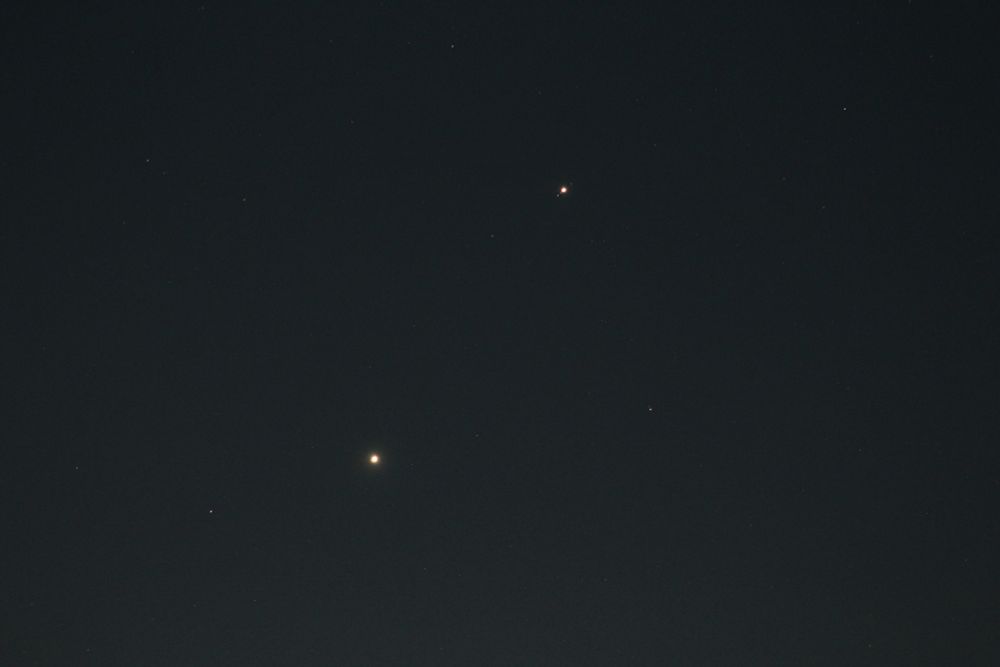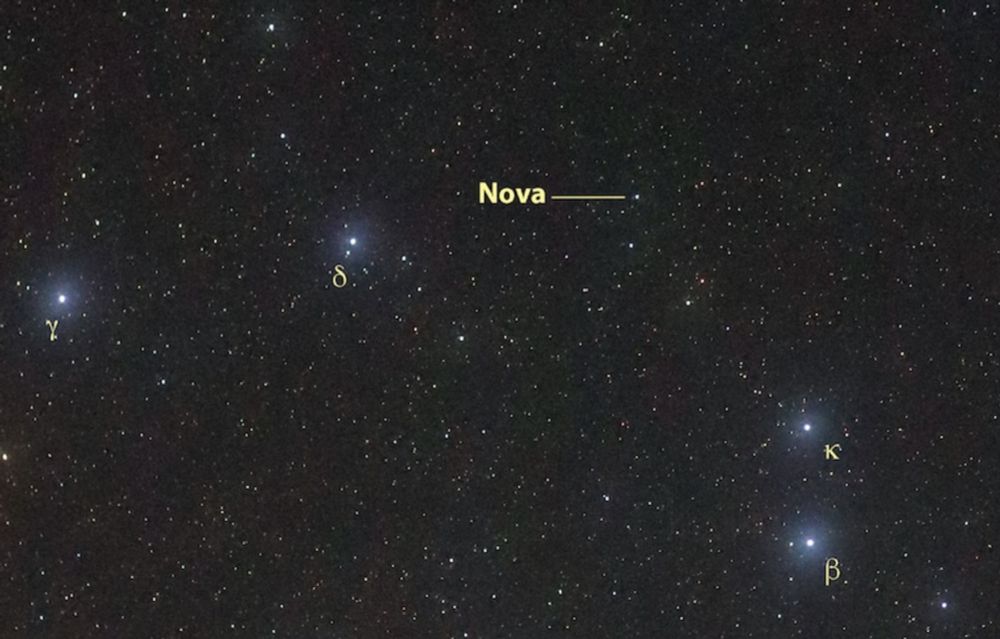Having an unobstructed view of the eastern horizon will allow for observing the Moon/Pleiades pair sooner, as they are lower in the sky. The bright moonlight will wash out any naked eye view of the Pleiades. But if you have binoculars or a telescope, the view will be more favorable.
- Joe Fragola
06.10.2025 19:29 — 👍 2 🔁 0 💬 0 📌 0
Mid-occultation will occur around 9:20 pm with the Moon sitting in the middle of the Pleiades cluster at an elevation of almost 11°. The occultation will end around 11 pm with the Moon and Pleiades at an elevation of 29°.
So, if the skies are clear Thursday night, step outside and take a look.
06.10.2025 19:29 — 👍 0 🔁 0 💬 1 📌 0
From San Jose, next week's lunar occultation of the Pleiades begins before 8 pm local time, while the Moon is still below the horizon. At Moonrise (8:12 pm), the occultation will continue, but it will still be a while before the Moon climbs high enough in the sky to get a good view.
06.10.2025 19:29 — 👍 0 🔁 0 💬 1 📌 0
Occultations are fairly common and can involve different combinations of objects. Lunar occultations occur when the Moon blocks the view of a planet or background star(s). Stellar occultations also happen when the light of a star is blocked by a planet or asteroid.
06.10.2025 19:29 — 👍 0 🔁 0 💬 1 📌 0
As the waning gibbous Moon rises on Thursday, October 9, it will be passing in front of the famous Pleiades star cluster (aka Messier 45). This type of event, known as an occultation, occurs when one celestial object temporarily blocks the view of another object. 🔭 🧪
06.10.2025 19:29 — 👍 4 🔁 0 💬 1 📌 0

Black background, white text. Text: by SJ Astronomy - Starry Nights Star Party - Saturday, October 11, 2025, 7:30 pm. RSVP on Meetup. Inset image: Banner of stars and star clusters across the middle of the graphic.
Join SJ Astronomy for our next Starry Nights Star Party - Saturday, October 11, 2025, 7:30 pm. 🔭 🧪
You must be a member of the SJ Astronomy Meetup group to register to attend (it's free): www.meetup.com/sj-astronomy/
Link for October 11 Starry Nights registration: www.meetup.com/sj-astronomy...
29.09.2025 19:58 — 👍 3 🔁 0 💬 0 📌 0

Alt Text
Astrophotograph of the entire Veil Nebula, seen as wisps of gas and dust forming a variety of shapes, from the hooded Eastern Nebula on the left to Pickering’s Triangle in the middle and the Witch’s Broomstick on the right.
Member Brad Haakenson captured this lovely image of the entire Veil Nebula on Monday night, September 22, 2025. It was a beautiful night at Rancho Cañada del Oro Open Space Preserve – warm with no dew and very clear. The seeing even improved through the night. 🧪 🔭
24.09.2025 18:09 — 👍 22 🔁 6 💬 0 📌 0
Comet 3I/ATLAS is the third known interstellar object, discovered in July, and is on a fast approach toward the Sun. It is currently about magnitude 14.8 and located in the constellation of Libra, between Zubenelgenubi and Zubeneschamali.
17.09.2025 19:12 — 👍 1 🔁 0 💬 0 📌 0
Comet 3I/ATLAS is getting lower in the sky but should be capturable with a smart scope and would be a good challenge object for larger telescopes in dark skies this week, leading into the new moon.
17.09.2025 19:12 — 👍 1 🔁 0 💬 1 📌 0

Astrophotograph showing numerous stars. In the center are two red lines, one vertical and one horizontal, indicating the location of interstellar comet 3I/ATLAS, seen as a faint fuzzy dot trailing a fuzzy tail to the lower right.
Member Michael Madden captured interstellar comet 3I/ATLAS using his Seestar S50 on September 13, 2025, at Rancho Cañada del Oro Open Space Preserve during a Starry Nights event. The Seestar was able to capture about 40 minutes of light until 3I/ATLAS disappeared below the ridge to the southwest. 🔭
17.09.2025 19:12 — 👍 10 🔁 0 💬 1 📌 0
Timelapse of the sunspots from the last Solar Sunday at Houge Park, September 7, 2025. This timelapse was captured over 2 hours, with over 8,000 pictures taken. It was taken on a Seestar S30 by member Creighton Voon.
#space #science #astronomy #astrophotography
16.09.2025 03:38 — 👍 28 🔁 2 💬 0 📌 0

SJAA 70th anniversary logo. Text: Public talk. The Talk: Member show and tell. Share your unique telescope builds, tell the story of your favorite astro-photos, pass on image processing tips, or brief astro-travelogues. October 4, 2025, Houge Park, San Jose, 7:30 pm. Inset images: (top left) A telescope in front of a blue sky. (top right) Photo of the night sky over trees with light pollution at the horizon. (bottom) Composite image of a telescope in front of the night sky, featuring the detailed band of the Milky Way over trees.
PUBLIC TALK: October 4, 2025, 7:30 pm
Our October meeting is for you to share your unique telescope builds, tell the story behind your favorite astro-photos, pass on image processing tips, or share brief astro-travelogues. 🔭 🧪 #BayArea
Sign up at our Meetup: www.meetup.com/sj-astronomy...
11.09.2025 23:09 — 👍 4 🔁 1 💬 0 📌 0

The beehive cluster of star dots at centre. Planet Venus disc lower right of frame.
Tomorrow morning Venus continues to appear close to the Beehive Cluster. 🔭 🧪 🎨 #astrophotography #SciArt #photography
01.09.2025 21:17 — 👍 86 🔁 10 💬 0 📌 1

The Western Veil Nebula is in the upper right, curving from top to the right, shown in purples and pinks. Pickering’s Triangle is on the left and “pointing” toward the center. Background stars fill the image.
Another great image from last week’s event at the Rancho Cañada del Oro Open Space Preserve! This picture of the Western Veil Nebula (Caldwell 34) and Pickering’s Triangle comes from member Kal Krishnan, using two hours of data with a dual-band (L-Enhance) filter on his Astro DSLR. 🔭 🧪
25.08.2025 20:00 — 👍 14 🔁 3 💬 1 📌 0

A red nebula reaches up through the night sky, vaguely shaped like the trunk of an elephant. Several bright stars dot the foreground of the image while many smaller stars are scattered throughout.
Member Doug Loyer captured this fantastic image of the Elephant Trunk Nebula (IC 1396A) earlier this week from the Rancho Cañada del Oro Open Space Preserve.
Collection and processing detail: Askar 120 APO, 63 x 60s images, ASI533MC, ZWO Duo Filter
Processed using Nebula Magic 🔭
#astrophotography
22.08.2025 17:38 — 👍 27 🔁 6 💬 0 📌 0
Apologies, everyone! The date on the graphic is correct: September 6, 2025, 7:30 pm. #bayarea 🔭 🧪
21.08.2025 22:26 — 👍 4 🔁 0 💬 2 📌 0

Text: THE TALK: The Challenges of Crewed Long-duration Exploration Missions to the Moon and Mars With Dr. Katya Arquilla, September 6, 2025, 7:30 pm, Houge Park, San Jose, CA. Inset photos: (top left) Photo of Dr. Katya Arquilla sitting in a NASA chair in front of two monitors and looking back at the camera. (top right) A group of four scientists in numbered space suits, working together with a robot dog in a Mars analog site on Earth. (bottom) A panoramic view of the Mars analog site, with red sedimentary rock in the foreground and thicker layered rock cliffs in the background, plus four scientists in orange jumpsuits on top of a mound.
PUBLIC TALK: July 12, 2025, 7:30 pm
Dr. Katya Arquilla will discuss how long-duration exploration missions present challenges more intense than those encountered in low-Earth orbit.
Sign up: www.meetup.com/sj-astronomy...
#astronomy #bayarea 🔭 🧪
19.08.2025 17:27 — 👍 4 🔁 1 💬 1 📌 1

Titan Shadow Transit Season Underway
Titan shadow transits are rare, occurring only about every 15 years. Don't miss the chance to see one this observing season.
A rare Titan shadow-transit season is happening now! Saturn’s largest moon is casting its shadow on the ice giant every 16 days through early October. So grab a telescope (3-in+), aim at dawn, and don’t miss this once-in-15-years chance. 🔭 🧪
skyandtelescope.org/astronomy-ne...
18.08.2025 01:28 — 👍 25 🔁 6 💬 0 📌 1

Planet Venus dot below centre. Planet Jupiter dot above centre.
Tomorrow Jupiter continues to appear close to Venus. Look east from around 3am. If awake enjoy the sight, if asleep have nice dreams. 🔭 🧪 🎨 #astrophotography #SciArt #photography #StormHour #ThePhotoHour
15.08.2025 17:35 — 👍 183 🔁 26 💬 11 📌 2

Star chart of constellations Cassiopeia and Andromeda with labeled Andromeda galaxy between them.
Would you like to see the #Andromeda galaxy? Here's how. 🌌
Tonight, try star-hopping to the Andromeda galaxy - 2.5 million light-years away - from the constellation #Cassiopeia. If your sky is dark, you might even spot this hazy patch of light with no optical aid.
buff.ly/zgwwj0y
📸 EarthSky.
14.08.2025 00:01 — 👍 15 🔁 5 💬 0 📌 1
Many thanks to the amazing rangers and staff at Yosemite National Park for helping to make this year's SJAA-led Glacier Point star party a huge success! The crescent moon rising over Half Dome, as seen in this all-sky timelapse taken on July 19th, perfectly punctuated this phenomenal experience. 🔭
13.08.2025 20:07 — 👍 47 🔁 9 💬 1 📌 0
REMINDER: Our next public talk is this weekend. Come join us! #BayArea 🔭🧪
07.07.2025 19:13 — 👍 4 🔁 1 💬 0 📌 0

Join the #ASP on Mon, June 30 at 5:30pm PT for a #FREE online screening of #SALLY — the story of astronaut Sally Ride and the love she kept hidden. Her partner, Tam O’Shaughnessy, shares their 27-year journey in this moving #NatGeo #doc. 🏳️🌈🔭🧪 #LoveIsLove
🎥 @sundance.org #filmfest
🔗 buff.ly/ctsFmYN
24.06.2025 22:47 — 👍 25 🔁 11 💬 1 📌 0

A nova or ‘new star’ in Lupus: Photos from our community
• Given the current brightness, binoculars can easily view the nova.
For more information, including photos and finder charts, check out this article from EarthSky: earthsky.org/todays-image...
25.06.2025 19:55 — 👍 2 🔁 1 💬 0 📌 0
• By June 18, it had brightened to magnitude 5.7, becoming visible to the naked eye. The star has continued brightening with a reported magnitude of 5.6 on June 21.
• Typically, novae can remain bright for a few weeks or months before the star returns to its previous brightness.
25.06.2025 19:55 — 👍 1 🔁 0 💬 1 📌 0
• The main goal of the project is to look for bright supernovae.
• The ASAS-SN telescope network can survey the entire sky approximately once every day.
• At its discovery, the white dwarf had already brightened to an apparent visual magnitude of 8.7, and it was classified as a nova on June 14.
25.06.2025 19:55 — 👍 0 🔁 0 💬 1 📌 0
• The nova was discovered 10 days ago (June 12) by the All Sky Automated Survey for Supernovae (ASAS-SN). This is a collection of 20 robotic telescopes in both the northern and southern hemispheres coordinated by astronomers from Ohio State University.
25.06.2025 19:55 — 👍 0 🔁 0 💬 1 📌 0
• The brightening was caused by a thermonuclear explosion, called a nova, on the surface of a white dwarf star in a binary star system. In this case, the white dwarf has been syphoning gas from a nearby red giant star.
25.06.2025 19:55 — 👍 0 🔁 0 💬 1 📌 0
Informing, entertaining, and inspiring people who are interested in the science and hobby of astronomy.
neuroscientist turned reporter at @ScienceNews.bsky.social • words also in Nature, SciAm, The Cancer Letter, etc • UCSC SciCom, NIH, UVA alum • she/her
website: meprillaman.com
signal: meprillaman.01
Celebrating and sharing Indigenous perspectives on the cosmos. From constellations rooted in Indigenous traditions to astrophotography, we want to share the unique stories and beauty of space.
Website | www.nativestargazers.org
Through its materials, resources, and programs, the ASP promotes public science interest, engagement, and literacy through the awe and wonder of astronomy and related fields. Founded in 1889, the ASP is the first national astronomy organization in the US.
I want to preserve the beauty & integrity of our night skies. Focusing mainly on raising awareness about the effects of light pollution, not only on astronomy but also on wildlife, human health & energy waste. - Dr Chris Spencer (aka @PixelatedDad)
Former rollerskating rink-turned-art-spaces in SJ. Over 30 artists working and teaching here. Open studio events monthly. You need more art.
1068 The Alameda, San Jose
Astronomy Acres Remote Observatories (AARO) is a remote hosting observatory for astrophotographers nestled under Bortle 1 skies in rural SW New Mexico.
To learn how we can host your gear - visit https://astronomyacres.com
Responsible for instigating some of humanity’s most high-impact discoveries.
Visit us at https://science.ucsc.edu/ 🐋 🔭 🧬
San José Spotlight is the city’s only nonprofit newsroom dedicated to independent political and business reporting. Help sustain our journalism: http://sanjosespotlight.com/support-us/
Official BlueSky of San José State Athletics. #AllSpartans
doing my best all day every day || formerly @sanjosespotlight.com @politico.com California || 🏳️🌈 || more at bscannestra.github.io
and you may ask yourself, how do i work this?
Mayor of San José. #BacktoBasics
Reporter @ The Mercury News | Mizzou J-school alum | 90s sitcom enthusiast | proud union member | climbing rocks in my spare time 🧗
tips: ghase@bayareanewsgroup.com
📍 San José | she/her/ela 🇺🇸 🇵🇹 | semi-reformed union thug turned comms girlie for @tordillosd3.bsky.social 🏙️ | Tudo vale a pena se a alma não é pequena 🌊
Artist, illustrator, designer and author. Fantasy art and astronomy art enthusiast.
https://www.artsource.nl
https://artsource-danielle.blogspot.com
Associate Professor of Physics and Astronomy at Purdue University. Excitable Explorer of the Universe.
Updates on your cosmos and world.
Lifelong sky watcher • Publisher of The Evening Sky Map (PDF) each month since January 2000: skymaps.com/tesm/ • Interests: Astronomy outreach • Astro-imaging • Supernovae | Career scientist (retired)
Kym Thalassoudis PhD
















